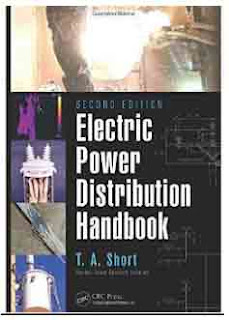ElECTRIC POWER distribution handbook
Contents1 Fundamentals of Distribution Systems1.1 Primary Distribution Configurations
1.2 Urban Networks
1.3 Primary Voltage Levels
1.4 Distribution Substations
1.5 Subtransmission Systems
1.6 Differences between European and North American Systems
1.7 Loads
1.8 The Past and the Future
References2 Overhead Lines2.1 Typical Constructions
2.2 Conductor Data
2.3 Line Impedances
2.4 Simplified Line Impedance Calculations
2.5 Line Impedance Tables
2.6 Conductor Sizing
2.7 Ampacities
2.7.1 Neutral Conductor Sizing
2.8 Secondaries
2.9 Fault Withstand Capability
2.9.1 Conductor Annealing
2.9.2 Burndowns
2.10 Other Overhead Issues
2.10.1 Connectors and Splices
1.2 Urban Networks
1.3 Primary Voltage Levels
1.4 Distribution Substations
1.5 Subtransmission Systems
1.6 Differences between European and North American Systems
1.7 Loads
1.8 The Past and the Future
References2 Overhead Lines2.1 Typical Constructions
2.2 Conductor Data
2.3 Line Impedances
2.4 Simplified Line Impedance Calculations
2.5 Line Impedance Tables
2.6 Conductor Sizing
2.7 Ampacities
2.7.1 Neutral Conductor Sizing
2.8 Secondaries
2.9 Fault Withstand Capability
2.9.1 Conductor Annealing
2.9.2 Burndowns
2.10 Other Overhead Issues
2.10.1 Connectors and Splices
| 2.10.2 References | Radio Frequency Interference |
3 Underground Distribution3.1 Applications
3.1.1 Underground Residential Distribution (URD)
3.1.2 Main Feeders
3.1.3 Urban Systems
3.1.4 Overhead vs. Underground
3.2 Cables
3.2.1 Cable Insulation
3.2.2 Conductors
3.1.1 Underground Residential Distribution (URD)
3.1.2 Main Feeders
3.1.3 Urban Systems
3.1.4 Overhead vs. Underground
3.2 Cables
3.2.1 Cable Insulation
3.2.2 Conductors
3.2.3 Neutral or Shield
3.2.4 Semiconducting Shields
3.2.5 Jacket
3.3 Installations and Configurations
3.4 Impedances
3.4.1 Resistance
3.4.2 Impedance Formulas
3.4.3 Impedance Tables
3.4.4 Capacitance
3.5 Ampacity
3.6 Fault Withstand Capability
3.7 Cable Reliability
3.7.1 Water Trees
3.7.2 Other Failure Modes
3.7.3 Failure Statistics
3.8 Cable Testing
3.9 Fault Location
References
3.2.4 Semiconducting Shields
3.2.5 Jacket
3.3 Installations and Configurations
3.4 Impedances
3.4.1 Resistance
3.4.2 Impedance Formulas
3.4.3 Impedance Tables
3.4.4 Capacitance
3.5 Ampacity
3.6 Fault Withstand Capability
3.7 Cable Reliability
3.7.1 Water Trees
3.7.2 Other Failure Modes
3.7.3 Failure Statistics
3.8 Cable Testing
3.9 Fault Location
References
4 Transformers4.1 Basics
4.2 Distribution Transformers
4.3 Single-Phase Transformers
4.4 Three-Phase Transformers
4.4.1 Grounded Wye – Grounded Wye
4.4.2 Delta – Grounded Wye
4.4.3 Floating Wye – Delta
4.4.4 Other Common Connections
4.4.4.1 Delta – Delta
4.4.4.2 Open Wye – Open Delta
4.4.4.3 Other Suitable Connections
4.4.5 Neutral Stability with a Floating Wye
4.4.6 Sequence Connections of Three-Phase Transformers
4.5 Loadings
4.6 Losses
4.7 Network Transformers
4.8 Substation Transformers
4.9 Special Transformers
4.9.1 Autotransformers
4.9.2 Grounding Transformers
4.10 Special Problems
4.10.1 Paralleling
4.10.2 Ferroresonance
4.10.3 Switching Floating Wye – Delta Banks
4.10.4 Backfeeds
Download

![Télécharger Liver GRAND GUIDE DU BRICOLAGE [PDF] gratuit](https://blogger.googleusercontent.com/img/b/R29vZ2xl/AVvXsEjCJ_C9aylfc7Z5ooUI6aUqBYB169jy3qIoLMK7ZCBkDpP2Totx-h1Ly2TqjNkPbxgnzaHuTK-cKzAtJH-csoy6oGmebZSQXyDi8dqoJvbwhh8yQTeZ0W_nVoug0uE7DWoUCuFmQ2sZpY8/s72-c/2019-04-18_180223.jpg)


